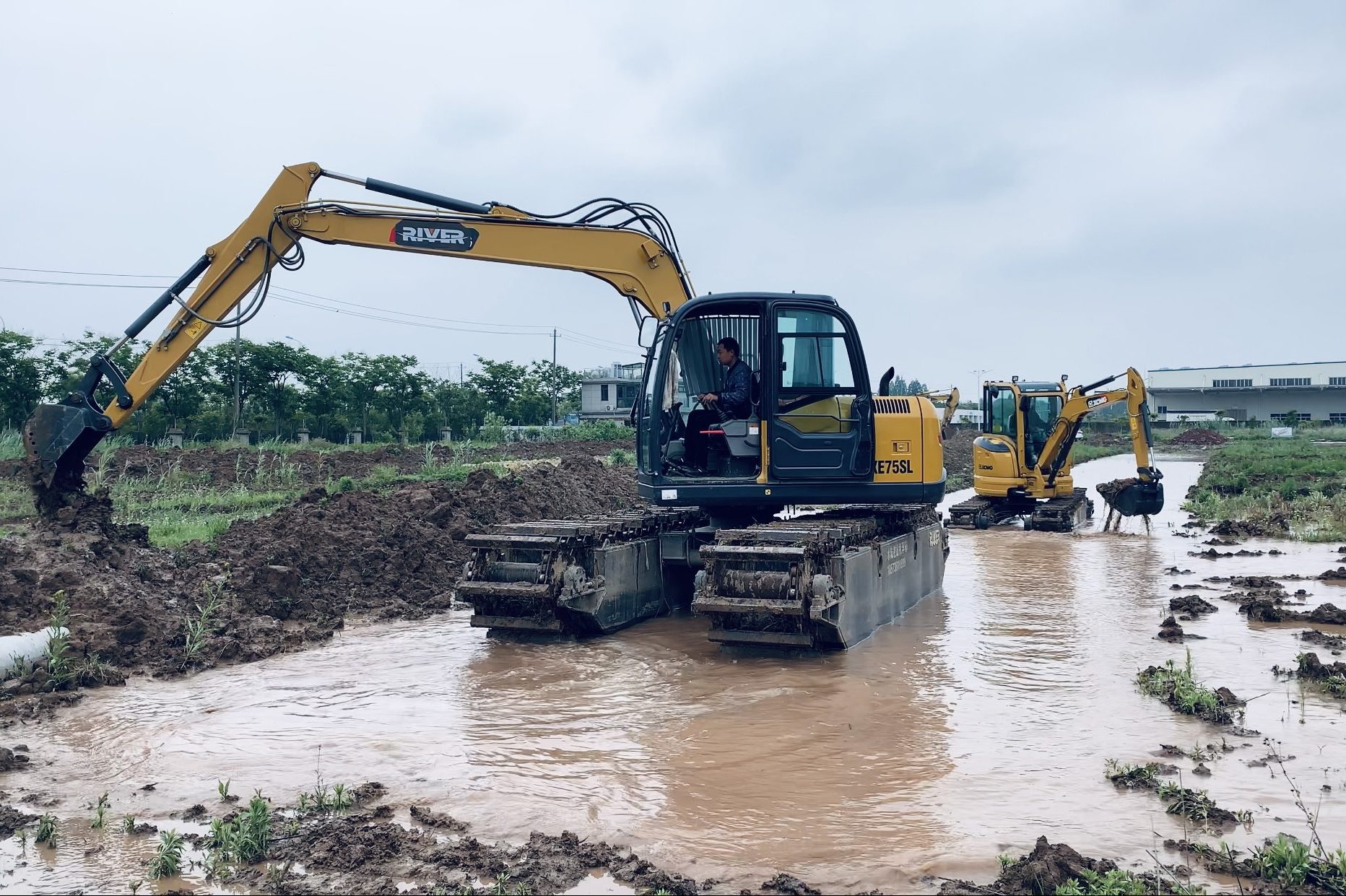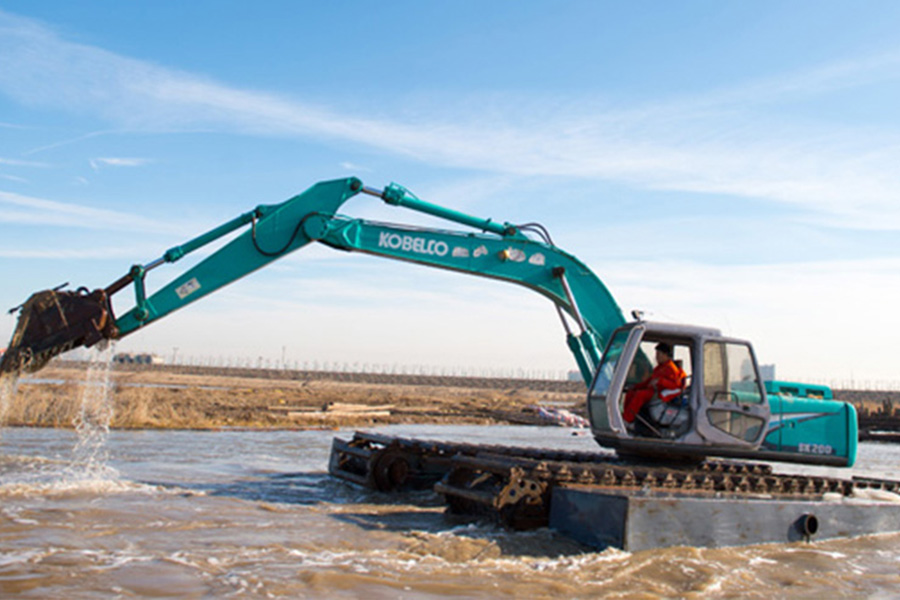Amphibious undercarriages are vital for projects in wet environments, providing the unique capability to navigate and function in areas saturated with water. Traditional construction equipment cannot operate in such conditions without sinking or causing environmental damage. The amphibious undercarriage resolves these issues, enabling machines to work effectively while preserving the delicate ecological balance of wetlands.
These specialized undercarriages are designed to distribute the weight of heavy machinery over a larger area, minimizing ground pressure and preventing the disturbance of the fragile wetland substrate. Their adaptability to terrestrial and aquatic settings makes them indispensable for various wetland construction tasks, from dredging to habitat restoration. In this post, we will learn how amphibious undercarriages operate and why they are necessary for wetland construction.
What Is an Amphibious Undercarriage?
An amphibious undercarriage is a specialized foundation for heavy machinery that enables it to operate in otherwise inaccessible areas to conventional equipment. It consists of buoyant structures supporting the machine, allowing it to traverse land and water with equal proficiency. This capability is crucial for construction and maintenance tasks in varied, challenging landscapes such as swamps and marshes.
By providing a floating platform, the amphibious undercarriage ensures that machinery can work on the water’s surface without compromising stability or performance. The adaptability of this system to function seamlessly across different terrains is a cornerstone of its design, making it an essential component for efficient and environmentally conscious wetland construction.
Parts of an Amphibious Undercarriage
The amphibious undercarriage system includes several key components that facilitate its ability to operate in areas with unstable ground. The following are the main components:
-
Excavator attachment (boom, arm, bucket)
The excavator attachment is a critical element that adapts to wet environments, allowing for efficient removal of sediment and debris from water bodies. The boom, arm, and bucket assembly is specifically engineered to maintain high levels of precision and power, distinguishing it from a traditional excavator by its ability to work in submerged conditions without compromising functionality.
-
Amphibious undercarriage (pontoons or tracks)
The pontoon undercarriage is the defining feature of an amphibious excavator. It comprises buoyant pontoons that enable the machine to stay afloat while performing tasks in water. These pontoons are engineered to provide a stable platform, ensuring the excavator remains balanced and operable even when navigating rough terrain or floating on water.
-
Hydraulic system for operating the excavator
The hydraulic system is central to operating amphibious excavators powering the movement of dredging equipment and other attachments. It is engineered to function reliably in aquatic environments and challenging terrains, ensuring that the excavator can perform various activities, from digging and trenching to precision work required for wetland restoration.
-
Cabin or operator’s platform for control and monitoring.
The cabin or operator’s platform is the command center from which all operations of the amphibious excavator are controlled and monitored. It is designed to provide maximum visibility, comfort, and safety for the operator, which is crucial for precision work in challenging conditions. The controls’ ergonomic design and the monitoring equipment’s strategic placement ensure that operations can be conducted efficiently and accurately.
How Does an Amphibious Undercarriage Work?
Amphibious undercarriages are designed to provide buoyancy and stability to excavation equipment, enabling it to operate in swampy areas where conventional excavators would fail. The undercarriage consists of pontoons that allow the machine to float and move across water surfaces while distributing weight when working on soft, muddy grounds.
The system is coupled with a hydraulic dredging pump and other necessary tools, turning the excavator into a versatile marsh buggy. Thanks to the combination of hydraulic power and the unique design of the undercarriage, the machine can perform a wide range of tasks, from digging to dredging, without additional support equipment.
Benefits of Amphibious Undercarriage
In 2023, the benefits of amphibious undercarriages are more apparent than ever, as they provide a sustainable and efficient solution for construction in wetlands and other aquatic environments. They allow for the seamless transition between land and water operations, reducing the need for multiple machines and saving time and resources.
Their design minimizes environmental impact, making them a preferred choice for eco-sensitive projects. The advanced technology incorporated into these undercarriages ensures that they meet modern construction demands while adhering to environmental regulations and preserving the integrity of natural habitats.
Corrosion-Resistant
Amphibious undercarriages are crafted with corrosion-resistant materials that withstand the harsh elements encountered in wetland environments. This durability ensures a longer lifespan for the machinery and reduces maintenance costs, making it a cost-effective choice for companies focused on wetland construction and maintenance.
The corrosion resistance is particularly important, as it prevents degradation of the undercarriage’s structural integrity, ensuring that the equipment remains safe and reliable for operators. The ability to resist corrosive substances like saltwater and mud keeps the machinery in optimal working condition, even in the most challenging situations.
High-Accuracy
High accuracy is a hallmark of modern amphibious undercarriages. Precision engineering allows meticulous control during excavation and dredging, ensuring that only the intended areas are affected. This level of accuracy is essential for protecting the delicate ecosystems within wetlands and meeting each construction project’s specific requirements.
The precision of these machines also means less rework and fewer errors, leading to more efficient operations. Enhanced accuracy reduces project timelines and costs, making amphibious undercarriages a wise investment for businesses aiming to maximize productivity.
Designed for Heavy Loads
Amphibious undercarriages are engineered to handle heavy loads, supporting the weight of the excavator and the materials it moves. This capability is essential for wetland construction projects, which often involve transporting and placing large volumes of earth and other materials.
The robust design of these undercarriages ensures stability and reliability under the weight of heavy loads, preventing the machine from becoming bogged down in soft soils. This strength is critical for maintaining progress in projects where the transportation of heavy materials is a daily requirement.
Work Under Extreme Weather Conditions
Amphibious undercarriages are built to operate under extreme weather conditions, ensuring that construction projects in wetlands can continue regardless of the climate. Their resilience to fluctuating temperatures, high humidity, and heavy rainfall makes them indispensable for year-round operations in diverse environmental settings.
This all-weather capability is crucial for meeting tight construction schedules and responding to urgent environmental restoration needs. By functioning effectively in adverse conditions, amphibious undercarriages help avoid costly delays and ensure the timely completion of critical projects.
Increase Productivity and Efficiency
Amphibious undercarriages significantly increase productivity and efficiency in wetland construction. Their ability to navigate land and water without additional transport or conversion saves valuable time, allowing crews to focus on the task rather than on logistical challenges.
The integration of advanced technology and design features streamlines operations, enabling faster project completion without sacrificing quality. This increased efficiency benefits the construction company in terms of reduced operational costs and positively impacts the environment by minimizing the duration of disturbances to the ecosystem.
BUY AMPHIBIOUS UNDERCARRIAGE HERE
Wetland Construction – Overview
Wetland construction involves specialized tasks such as habitat creation, erosion control, and water management, all requiring machinery that can navigate sensitive terrains without causing damage. Amphibious undercarriages enable the precise execution of these tasks, providing a stable platform for operators to work from, whether on solid ground or over water.
Amphibious undercarriages’ seamless work in wetland areas makes essential tools for projects aimed at conserving and restoring these vital ecosystems. They ensure construction is carried out responsibly, focusing on preserving the natural environment for future generations.
Why Amphibious Carriage Is Essential for Wetland Construction?
Amphibious carriages are pivotal in wetland construction due to the unique challenges faced by swampy areas. These specialized vehicles, equipped with an innovative undercarriage, provide the necessary support and mobility to navigate the unstable ground. Their capacity to sustain heavy machinery while mitigating environmental impact is unmatched by traditional construction equipment.
In wetland environments, the amphibious undercarriage’s adaptability allows for the efficient transportation of wetland equipment across soft, muddy terrains. Integrating hydraulic systems ensures the smooth operation of attachments, which is crucial for the delicate balance of progressing construction while preserving the ecosystem’s integrity.
Removing sediment and debris from water bodies
Wetland construction often involves the critical task of removing sediment and debris from water bodies. Amphibious carriages, with their specialized swamp buggies, excel in this role, enabling access to areas that would otherwise be unreachable by conventional machinery. The buoyancy and traction the amphibious undercarriage provides allow for safe and effective removal without disturbing the surrounding habitat.
The hydraulic systems on these vehicles are designed to handle the fluid dynamics of wetland environments, thus enhancing the efficiency of sediment extraction. This capability ensures cleaner waterways, which is essential for the health of aquatic life and the overall ecosystem.
Clearing vegetation and invasive species
Amphibious carriages are significant in clearing vegetation and invasive species that can choke wetlands. Their ability to reach dense areas and float amidst the marshy conditions allows for the precise deployment of excavation equipment. These specialized machines can swiftly remove unwanted flora without causing undue harm to the fragile wetland terrain.
Such equipment is essential for maintaining the balance of native ecosystems. By removing invasive species, amphibious carriages help restore the natural order and promote biodiversity within the wetland areas.
Restoring natural habitats and ecosystems
Restoring natural habitats and ecosystems is a delicate process that demands specialized equipment. Amphibious undercarriages enable the safe and efficient transport of materials and machinery necessary for these vital efforts. Their presence is integral to the successful re-establishment of native plant life and the re-creation of habitats that support local wildlife.
Through their ability to tread lightly yet effectively across sensitive areas, amphibious carriages help minimize construction footprints. This ensures that ecosystems’ natural recovery can proceed with minimal human-induced stress or alteration.
Constructing or maintaining water channels, ponds, and wetland features.
Constructing or maintaining water channels, ponds, and wetland features is fundamental for flood control and the overall health of wetlands. Amphibious carriages, buoyancy through hermetically sealed pontoons, provide the necessary stability and support for such tasks. This enables them to carry heavy loads and traverse aquatic environments without causing damage.
The track chain’s durability and the amphibious undercarriage’s design are specifically tailored to meet the demands of wetland construction. They offer a reliable platform for building and maintaining essential water management structures, which are vital for the sustainability of these complex ecosystems.
BUY AMPHIBIOUS UNDERCARRIAGE HERE
How do Amphibious Undercarriages Navigate in Wetland Environments?
Amphibious undercarriages navigate wetland environments with various applications, bringing versatility to the construction industry. The use of high-strength steel in their construction ensures resilience against the elements. At the same time, the design enables them to distribute weight evenly, providing efficiency and stability over a wider area. This is particularly advantageous in North America and Europe, where industrial projects require workers to build platforms before operating heavy equipment.
In soft terrain, the hydraulic power of amphibious carriages is essential for propulsion, allowing the excavator to float in shallow waters. These vehicles are designed to meet the rigorous demands of operating heavy equipment in swamps, contributing to tasks for different industrial applications. Their navigation capabilities are crucial for wetland conservation and the progress of sustainable construction practices.
Wrap-Up!
Amphibious carriages play a crucial role in the construction and maintenance of wetlands. They provide access to remote areas that are otherwise difficult to reach, ensuring that sensitive areas are preserved during construction activities. Their specialized design allows for the safe removal of invasive species and supports flood and disaster recovery efforts.
Using an amphibious pontoon system extends the capability of construction equipment, enabling it to perform many tasks while minimizing environmental impact. As wetland management and construction needs evolve, the amphibious carriage remains an indispensable asset for tackling the unique challenges of these vital ecosystems.


